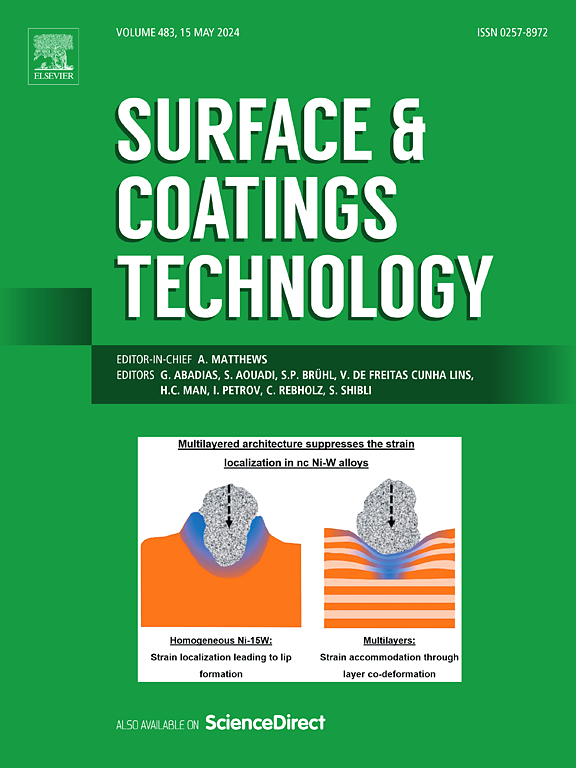In-situ construction of the hydrophobic structure to improve the corrosion resistance on TA1 pure titanium by vacuum heat treatment
IF 5.3
2区 材料科学
Q1 MATERIALS SCIENCE, COATINGS & FILMS
引用次数: 0
Abstract
The inherent hydrophilicity of titanium causes biological contamination and corrosion, limiting their widespread applications. In this work, the limitations of conventional coating processes were overcome by modifying the microstructure of TA1 pure titanium via vacuum heat treatment. A hydrophilic-to-hydrophobic transition (Contact angle increased tenfold) was achieved, along with improved corrosion resistance. Above phase transition temperature (882 °C), a stepped microstructure and a preferential orientation of low-energy and grain surfaces were formed on the TA1 pure titanium. A reduction in surface energy was induced through the synergistic effects of grain coarsening, grain orientation, and surface roughening, resulting in a contact angle exceeding 90°. Compared with untreated samples, electrochemical testing showed that the corrosion current density (icorr) of samples treated at 950 °C decreased by 81 %, and the charge transfer resistance (Rp and Rb) increased by about 10 times, confirming a correlation between hydrophobicity and corrosion resistance. However, treatment above 1050 °C led to performance decline due to grain refinement and increased high-energy surface fractions. This work demonstrates that vacuum heat treatment can simultaneously enhance hydrophobicity and corrosion resistance in TA1 pure titanium, providing a promising strategy for surface modification of uncoated metals in marine engineering and biomedical applications.

通过真空热处理原位构建疏水结构,提高TA1纯钛的耐蚀性
钛固有的亲水性会引起生物污染和腐蚀,限制了其广泛应用。通过真空热处理对TA1纯钛的微观结构进行改性,克服了传统涂层工艺的局限性。实现了亲水性到疏水性的转变(接触角增加了10倍),同时提高了耐腐蚀性。在相变温度(882℃)以上,TA1纯钛表面形成阶梯状微观结构,低能101¯0和112¯0晶粒表面优先取向。晶粒粗化、晶粒取向和表面粗化的协同作用导致表面能降低,导致接触角超过90°。电化学测试表明,与未处理样品相比,950℃处理样品的腐蚀电流密度(icorr)降低了81%,电荷转移电阻(Rp和Rb)增加了约10倍,证实了疏水性与耐腐蚀性之间的相关性。然而,当处理温度高于1050°C时,由于晶粒细化和表面高能组分增加,导致性能下降。本研究表明,真空热处理可以同时增强TA1纯钛的疏水性和耐腐蚀性,为海洋工程和生物医学应用中无涂层金属的表面改性提供了一种有前途的策略。
本文章由计算机程序翻译,如有差异,请以英文原文为准。
求助全文
约1分钟内获得全文
求助全文
来源期刊

Surface & Coatings Technology
工程技术-材料科学:膜
CiteScore
10.00
自引率
11.10%
发文量
921
审稿时长
19 days
期刊介绍:
Surface and Coatings Technology is an international archival journal publishing scientific papers on significant developments in surface and interface engineering to modify and improve the surface properties of materials for protection in demanding contact conditions or aggressive environments, or for enhanced functional performance. Contributions range from original scientific articles concerned with fundamental and applied aspects of research or direct applications of metallic, inorganic, organic and composite coatings, to invited reviews of current technology in specific areas. Papers submitted to this journal are expected to be in line with the following aspects in processes, and properties/performance:
A. Processes: Physical and chemical vapour deposition techniques, thermal and plasma spraying, surface modification by directed energy techniques such as ion, electron and laser beams, thermo-chemical treatment, wet chemical and electrochemical processes such as plating, sol-gel coating, anodization, plasma electrolytic oxidation, etc., but excluding painting.
B. Properties/performance: friction performance, wear resistance (e.g., abrasion, erosion, fretting, etc), corrosion and oxidation resistance, thermal protection, diffusion resistance, hydrophilicity/hydrophobicity, and properties relevant to smart materials behaviour and enhanced multifunctional performance for environmental, energy and medical applications, but excluding device aspects.
 求助内容:
求助内容: 应助结果提醒方式:
应助结果提醒方式:


